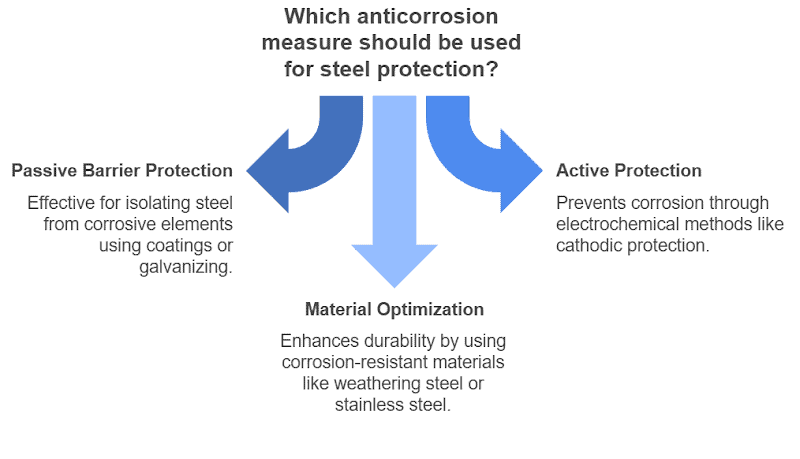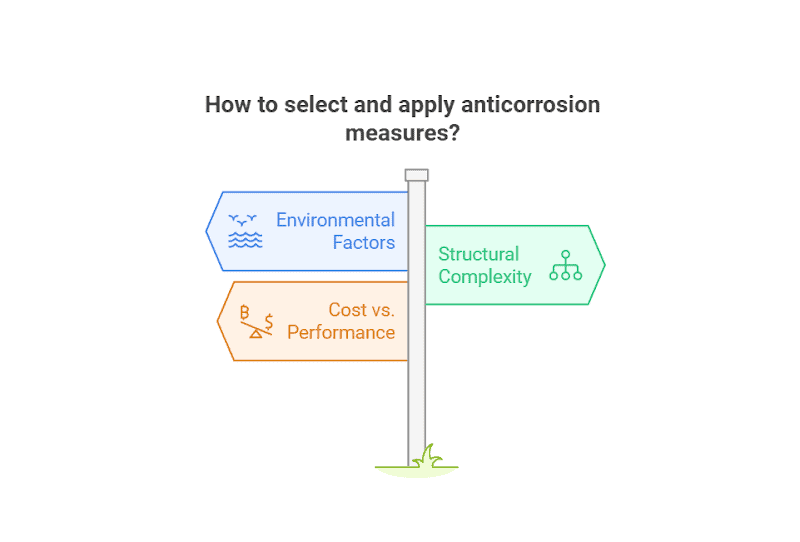Steel structures are everywhere in modern construction, thanks to their strength, durability, and versatility. But, like everything else, they’re not immune to corrosion from things like moisture, salt, and chemicals. That’s why it’s so important to have effective anti-corrosion measures in place—not just to extend the life of the structure, but to keep it safe and save on maintenance costs in the long run.
In this article, we’ll dive into the main methods for protecting steel from corrosion, offering practical insights to help you get the best results.
Why Steel Structures Corrode and the Risks
Steel is a durable and strong material, but it can still be vulnerable to damage. Over time, exposure to certain environmental factors can cause corrosion, which poses significant risks to the structure’s integrity. The main factors contributing to corrosion include:
- Moisture: Exposure to water, especially in humid environments or places prone to rainfall, accelerates corrosion.
- Salt: Coastal areas with salt-laden air or industrial facilities using chemicals increase the risk of corrosion.
- Pollution: Industrial pollution, especially acidic compounds, can also contribute to faster deterioration of steel surfaces.
As corrosion progresses, the risks become more serious. Not only does it compromise the strength and load-bearing capacity of the structure, but it can also:
- Weaken critical components: Rusting can lead to a gradual loss of structural integrity, making the building less stable.
- Increase safety hazards: In extreme cases, unchecked corrosion can lead to catastrophic failures, particularly in bridges, high-rise buildings, and industrial facilities.
- Raise long-term costs: Left untreated, corrosion requires more frequent repairs and can even prematurely replace structural elements, leading to higher maintenance costs.
Related Reading: How to Remove Rust from Steel Beams and Steel Structures?
Understanding the causes of corrosion is the initial step in safeguarding your steel. Let’s look at the main anticorrosion methods.
Types of Anticorrosion Measures
When it comes to protecting steel, there are a few different approaches—passive barrier protection, active protection, and material optimization. Each option has its own benefits, and the right choice depends on the particular needs of your project.

Passive Barrier Protection
Protective Coatings
Protective coatings are the most commonly used method for steel anti-corrosion. A continuous barrier is formed to isolate the steel from corrosive elements by applying layers of paint or specialized coatings.Depending on the environment and the project, different types of coatings can be used:
- Epoxy coatings are well-suiteare ideal for harsh environments due to their strong adhesion and chemical resistance.
- Polyurethane coatings offer excellent weather resistance and are often used as topcoats.
- Fluorocarbon coatings provide superior durability and UV resistance, making them perfect for iconic structures like airports and stadiums.
In our experience, choosing the right coating system depends on the environmental corrosion category (ISO 12944). For example:
- C3 environments (moderate corrosion, like urban or industrial areas) benefit from a combination of epoxy zinc-rich primer, epoxy micaceous iron oxide, and acrylic polyurethane topcoat. This offers a practical balance between cost and performance.
- C5-M environments (high corrosion, like offshore or coastal areas) require heavy-duty coatings such as fluorocarbon or polysiloxane, designed for extreme conditions.
Proper surface preparation and coating thickness are key to long-lasting protection, reducing maintenance costs and ensuring steel structures stand strong throughout their lifespan.
Hot-Dip Galvanizing
Hot-dip galvanizing involves immersing steel components in molten zinc to create a robust, corrosion-resistant coating. This method is especially effective for outdoor structures exposed to harsh weather conditions.
- Applications: Transmission towers, streetlight poles, and highway guardrails.
- Advantages: Long-lasting protection with minimal maintenance.
We recently utilized hot-dip galvanizing for the wall panels of a commercial office buildings in a coastal area, ensuring they remain corrosion-free for over 50 years with minimal upkeep.
Active Protection
Cathodic Protection
Cathodic protection prevents corrosion by turning the steel structure into the cathode in an electrochemical circuit, which stops oxidation and rust formation. Controlling electron flow safeguards the steel in corrosive environments. Two primary methods achieve this, each suited to specific applications. Below, we explore these methods in detail.
Sacrificial Anode Method
How it works: This method uses metals like magnesium or zinc as sacrificial anodes. These anodes corrode instead of the steel, thus protecting the structure.
Pros:
- Simple and cost-effective for smaller structures.
- Reliable and proven in many applications.
Cons:
- The lifespan of the sacrificial anodes is limited, requiring regular replacement.
- It is unsuitable for large structures due to the high volume of anodes needed.
Applications:
- Underground or underwater structures include pipelines, dock pilings, and tanks.
- Used in smaller-scale projects or localized areas where corrosion risk is high.
Impressed Current Method
How it works: This method utilizes an external power source to deliver a continuous current to the steel structure, effectively preventing corrosion over time. Anodes of materials like graphite or mixed metal oxide are placed near the structure.
Pros:
- Can be used for large-scale structures with minimal maintenance.
- Longer service life compared to sacrificial anodes.
Cons:
- The initial installation cost is higher because of the need for a power supply and monitoring equipment.
- Requires careful monitoring and maintenance to ensure the system is functioning properly.
Applications:
- Large-scale projects such as offshore platforms, bridges, and buried pipelines.
- Suitable for structures in harsh environments that require long-term protection.
You can ensure long-term protection and minimize maintenance costs by choosing the right method—sacrificial anode for smaller projects or impressed current for large-scale applications.
Material Optimization
Using corrosion-resistant materials enhances durability with minimal maintenance. Below, we explore two key options: weathering steel and stainless/alloy steels.
Weathering Steel
Weathering steel, also known as corten steel, contains alloying elements like copper, chromium, and nickel. These elements create a stable rust layer that acts as a protective barrier for the underlying steel, minimizing the need for extra coatings.
- Applications: Architectural projects where a rustic appearance is desired, such as museums and cultural centers.
Weathering steel is great for corrosion resistance, but surface prep is key. Removing oil, rust, and mill scale boosts its protection. A quick abrasive blast to Sa2.5 ensures it stays strong for the long haul—no extra coatings needed.
Stainless and Alloy Steel
Another effective strategy is using inherently corrosion-resistant materials, such as stainless steel or alloy steels.
- Applications: These materials are ideal for extreme environments, such as chemical plants or coastal installations, where traditional methods may fall short.
Steel buildings often use different types of steel, so be cautious of electro galvanic corrosion when stainless steel contacts metals like carbon steel or copper. To prevent this, avoid direct contact or use gaskets or coatings to isolate the metals and protect against corrosion.
Selecting and Applying Anticorrosion Measures
Picking the right anticorrosion method isn’t one-size-fits-all—it really depends on the environment, structure, and budget. Often, a mix of methods works best. For example, combining coatings with cathodic protection can offer solid protection in those tough, corrosive spots.

Environmental factors are a big deal. If you’re in a coastal area with salty air, you’ll want a stronger system, like epoxy primers paired with cathodic protection. But for less demanding environments, simple coatings will do the trick just fine.
When it comes to structural complexity, don’t forget about the tricky spots! Hard-to-reach areas might need specialized options like thermal spray coatings to get full coverage.
And, of course, balancing cost and performance is key. Sure, fluorocarbon coatings or impressed current systems might cost more upfront, but they can save you in maintenance over the years. The goal? A customized strategy that gives you the best protection, at the right price, for the long haul.
Maintenance and Management of Anticorrosion Systems
Regular inspection and proactive management are essential to keep your anticorrosion measures working effectively. Here are some key maintenance tips:
- Routine Inspections: Check for coating damage, rust spots, or signs of anode depletion. Early detection helps avoid more significant problems in the future.
- Monitor Coating Integrity: Periodically inspect coatings for wear, cracking, or chipping. Touch up damaged areas promptly to maintain continuous protection.
- Reapply Protective Coatings: Over time, coatings can degrade. Plan for reapplication every few years depending on environmental exposure and wear.
- Anode Replacement: In cathodic protection systems, regularly check for anode depletion and replace them as needed to ensure continuous protection.
- Environmental Monitoring: Track changes in weather conditions, humidity, and salinity in coastal areas that may affect corrosion rates. Adjust your maintenance schedule according to these factors.
- Record Keeping: Keep a maintenance log of inspections, repairs, and updates. This ensures consistency and offers valuable data for future projects.
- Professional Inspections: For complex structures or harsh environments, consider hiring specialists to conduct detailed inspections and suggest any advanced treatments or repairs.
Why Choose Us as Your Steel Structure Manufacturer
Protecting steel structures from corrosion is crucial for ensuring their long-term durability and safety. By selecting and applying the right anticorrosion methods, you can greatly improve the performance and value of your projects.
As a trusted manufacturer of steel structures, we specialize in providing high-quality, corrosion-resistant solutions tailored to your specific needs. For instance, in a recent project with a coastal municipality, we delivered a steel framework for a waterfront facility that combined hot-dip galvanizing with fluorocarbon coatings. This combination not only met but exceeded expectations, delivering exceptional longevity and performance. We also offer steel structure office buildings designed to meet the highest standards of quality and durability.
With our expertise, we guarantee that your projects not only meet but often exceed industry standards for durability and safety. Whether it’s a small installation or a large industrial complex, we are committed to providing structures that stand the test of time.

